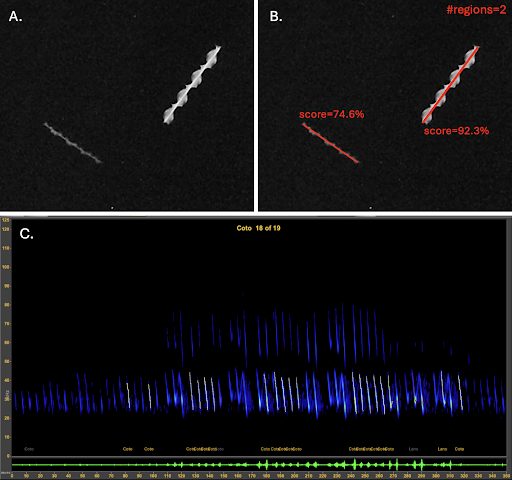Bats provide critical pest control services in agricultural landscapes, yet agriculture poses significant direct and indirect threats to bats, primarily through habitat alteration and driving insect declines. This project investigated how agroecological land use—including the types of crops, the amount of protected land, and habitat restoration through the USDA Conservation Reserve Program (CRP)—affects bat activity and diversity in the Columbia Plateau ecoregion of Eastern Washington, focusing on the state candidate species, Townsend’s big-eared bat (Corynorhinus townsendii), and other bat species of conservation concern.
We deployed acoustic monitors to monitor bats and camera traps to monitor nocturnal flying insects across nine protected sites (BLM and WDFW) in Douglas County from July–October 2024 and March–June 2025, spanning 163 monitoring nights. These sites represented a gradient of surrounding land types—cropland, CRP restoration, and protected natural habitat. Using generalized linear mixed-effects models, we analyzed how bat activity, species richness, diversity, and feeding behavior were influenced by environmental variables including climate, land cover, water features, and nocturnal flying insect abundance.
Key Findings
We recorded all 14 bat species expected in the region, including all Washington State Species of Greatest Conservation Need (SGCN) expected in the region. We detected C. townsendii 19 times across six of nine sites and all three study regions. Temperature emerged as the dominant environmental driver of bat activity, with both short-term nightly temperatures and long-term minimum temperatures strongly predicting bat diversity, activity, and feeding intensity.
Agricultural practices showed contrasting effects on bat communities. Insect-pollinated crops and greater crop diversity within 2–5 km were strongly associated with increased bat diversity and activity, particularly benefiting C. townsendii and other moth specialists, while more wind-pollinated crops at 20 km scales were associated with decreased bat diversity and activity. Bat activity, diversity, and foraging showed consistent negative relationships with CRP land across multiple spatial scales and CRP practices, including permanent grass plantings (CP1, CP2) and wildlife enhancements (CP38E).
Protected areas increased the chances of detecting several species, including C. townsendii. The presence of more springs and seeps had positive effects on total bat diversity and activity, underscoring the importance of water features for bats. Nocturnal insect abundance showed modest but significant effects on bat feeding activity, with fine-scale temporal correlations observed throughout the night.
Management Implications
These findings indicate that diverse bat communities, including vulnerable species like C. townsendii, are an active and important component of the agricultural landscapes of Eastern Washington. The positive associations between bats and diverse insect-pollinated crops suggests that diversified agricultural systems may provide more valuable foraging habitat than simplified agricultural systems composed primarily of cereal grains, and perhaps more even than grassland restoration through the CRP. Indeed, although they warrant further investigation, our results suggest that in order to better support bats, the CRP should strive to encompass habitat types and landscape features, such as water sources, that bats and their insect prey rely on. Furthermore, our results highlight that maintaining and expanding protected areas, particularly those that include water sources, is critical for the conservation of rare and vulnerable species like C. townsendii in agricultural landscapes.
Recommendations
- Expand protected areas in key habitat areas for C. townsendii and other rare and vulnerable bat species
- Prioritize conservation efforts for C. townsendii in northern Douglas County, where the species mostly occurs
- Prioritize protection and restoration of springs, seeps, and other point water sources in agricultural landscape conservation planning
- Investigate additional factors (e.g., contract age) that may affect the value of CRP land to bats, and reevaluate CRP habitat management practices to incorporate habitat features that better support bats and their insect prey
- Encourage diverse crop rotations that include insect-pollinated species
- Implement long-term monitoring programs using validated passive acoustic and camera-based techniques








